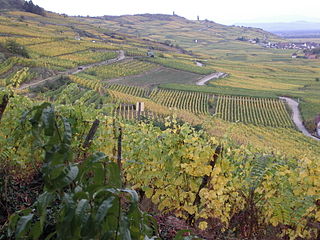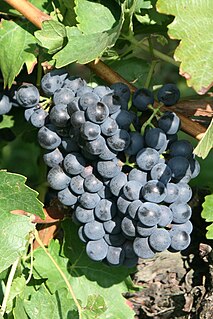Related Research Articles

Dessert wines, sometimes called pudding wines in the United Kingdom, are sweet wines typically served with dessert.

Sparkling wine is a wine with significant levels of carbon dioxide in it, making it fizzy. While the phrase commonly refers to champagne, EU countries legally reserve that term for products exclusively produced in the Champagne region of France. Sparkling wine is usually either white or rosé, but there are examples of red sparkling wines such as the Italian Brachetto, Bonarda and Lambrusco, and the Australian sparkling Shiraz. The sweetness of sparkling wine can range from very dry brut styles to sweeter doux varieties.

Pinot blanc is a white wine grape. It is a point genetic mutation of Pinot noir. Pinot noir is genetically unstable and will occasionally experience a point mutation in which a vine bears all black fruit except for one cane which produces white fruit.
Pinot gris, pinot grigio or Grauburgunder is a white wine grape variety of the species Vitis vinifera. Thought to be a mutant clone of the pinot noir variety, it normally has a grayish-blue fruit, accounting for its name but the grapes can have a brownish pink to black and even white appearance. The word pinot could have been given to it because the grapes grow in small pine cone-shaped clusters. The wines produced from this grape also vary in color from a deep golden yellow to copper and even a light shade of pink, and it is one of the more popular grapes for skin-contact wine.

Furmint is a white Hungarian wine grape variety that is most noted widely grown in the Tokaj-Hegyalja wine region where it is used to produce single-varietal dry wines as well as being the principal grape in the better known Tokaji dessert wines. It is also grown in the tiny Hungarian wine region of Somló. Furmint plays a similar role in the Slovakian wine region of Tokaj. It is also grown in Austria where it is known as Mosler. Smaller plantings are found in Slovenia where it is known as Šipon. The grape is also planted in Croatia, where it is known as Moslavac. It is also found in Romania and in former republics of the Soviet Union. Furmint is a late ripening variety. For dry wines the harvest starts usually in September, however sweet wine specific harvest can start in the second half of October or even later, and is often affected by Botrytis.

Late harvest wine is wine made from grapes left on the vine longer than usual. Late harvest is usually an indication of a sweet dessert wine, such as late harvest Riesling. Late harvest grapes are often more similar to raisins, but have been naturally dehydrated while on the vine.

Grüner Veltliner is a white wine grape variety grown primarily in Austria, Hungary, Slovakia, and the Czech Republic. The leaves of the grape vine are five-lobed with bunches that are long but compact, and deep green grapes that ripen in mid-late October in the Northern Hemisphere.

Oak is used in winemaking to vary the color, flavor, tannin profile and texture of wine. It can be introduced in the form of a barrel during the fermentation or aging periods, or as free-floating chips or staves added to wine fermented in a vessel like stainless steel. Oak barrels can impart other qualities to wine through evaporation and low level exposure to oxygen.

Blaufränkisch is a dark-skinned variety of grape used for red wine. Blaufränkisch, which is a late-ripening variety, produces red wines which are typically rich in tannin and may exhibit a pronounced spicy character.

Alsace wine or Alsatian wine is produced in the Alsace region in France and is primarily white wine. Because of its Germanic influence, it is the only Appellation d'Origine Contrôlée region in France to produce mostly varietal wines, typically from similar grape varieties to those used in German wine. Along with Austria and Germany, it produces some of the most noted dry Rieslings in the world as well as highly aromatic Gewürztraminer wines. Wines are produced under three different AOCs: Alsace AOC for white, rosé and red wines, Alsace Grand Cru AOC for white wines from certain classified vineyards and Crémant d'Alsace AOC for sparkling wines. Both dry and sweet white wines are produced.

Müller-Thurgau is a white grape variety which was created by Hermann Müller from the Swiss Canton of Thurgau in 1882. It is a crossing of Riesling with Madeleine Royale. It is used to make white wine in Germany, Austria, Northern Italy, Hungary, England, Australia, the Czech Republic, Slovakia, Slovenia, New Zealand, Canada, the United States and Japan. There are around 42,000 hectares (104,000 acres) cultivated worldwide, which makes Müller-Thurgau the most widely planted of the so-called "new breeds" of grape varieties created since the late 19th century. Although plantings have decreased significantly since the 1980s, as of 2006 it was still Germany's second most planted variety at 14,000 hectares and 13.7% of the total vineyard surface. In 2007, the 125th anniversary was celebrated at the Geisenheim Grape Breeding Institute. Müller-Thurgau is also known as Rivaner, Riesling x Sylvaner, Riesling-Sylvaner (Switzerland), Johannisberg, Rizvanec (Slovenia) and Rizlingszilváni (Hungary).

Jancis Mary RobinsonOBE, ComMA, MW is a British wine critic, journalist and wine writer. She currently writes a weekly column for the Financial Times, and writes for her website JancisRobinson.com, updated daily. She also provides advice for the wine cellar of Queen Elizabeth II.

Kiskőrös is a town in Bács-Kiskun, Hungary. Kiskőrös is situated between the Danube and Tisza rivers at around 46°37′14″N19°17′19″E. Sándor Petőfi, the national poet of Hungary, was born here.

Blauer Portugieser is a red Austrian, Slovenian wine and German wine grape found primarily in the Rheinhessen, Pfalz and wine regions of Lower Austria and Slovenia. It is also one of the permitted grapes in the Hungarian wine Egri Bikavér. In Germany, the cultivated area covered 4,551 hectares or 4.5% of the total vineyard area in 2007. Wine cellars usually vinify a simple light red wine, which is characterized by a fresh, tart and light body. It is also frequently vinified as a rosé. Blauer Portugieser is also very well suited as table grapes; however, it is not sold as such because the selling of wine grapes as table grapes is not permitted in the European Union. Since 2000, higher quality wines have been vinified from Portugieser grapes. The use of oak provides additional aromas in order to compete with Bordeaux varieties. DNA profiling has shown that Blauer Portugieser is a cross between Grüner Silvaner and Blaue Zimmettraube. Historical ampelographic sources have provided very solid evidence that the geographic area of origin of the variety is Lower Styria.
Sauvignon vert is a white wine grape of the species Vitis vinifera prevalent in the Italian region of Friuli. It is widely planted in Chile where it was historically mistaken for Sauvignon blanc. The grape is distinct from the California planting of Muscadelle which is also called Sauvignon vert.

Lesbos wine is wine made on the Greek island of Lesbos in the Aegean Sea. The island has a long history of winemaking dating back to at least the 7th century BC when it was mentioned in the works of Homer. During this time the area competed with the wines of Chios for the Greek market. An apocryphal account details one of the brothers of the poet Sappho as a merchant trading Lesbos wine with the Greek colony of Naucratis in Egypt. The most noted Lesbos wine was known as Pramnian which draws similarities today to the Hungarian wine Eszencia. The popularity of Lesbos wine continued into Roman times where it was highly valued along with other Aegean wines of Chios, Thasos and Kos.

Friuli-Venezia Giulia wine is wine made in the northeastern Italian region of Friuli-Venezia Giulia. Once part of the Venetian Republic and with sections under the influence of the Austro-Hungarian Empire for some time, the wines of the region have noticeable Slavic and Germanic influences. There are 11 Denominazione di origine controllata (DOC) and 3 Denominazione di Origine Controllata e Garantita (DOCG) in the Friuli-Venezia Giulia area. The region has 3 Indicazione Geografica Tipica (IGT) designations Alto Livenza, delle Venezie and Venezia Giulia. Nearly 62% of the wine produced in the region falls under a DOC designation. The area is known predominantly for its white wines which are considered some of the best examples of Italian wine in that style. Along with the Veneto and Trentino-Alto Adige/Südtirol, the Friuli-Venezia Giulia forms the Tre Venezie wine region which ranks with Tuscany and Piedmont as Italy's world class wine regions.

Zierfandler is a grape variety used to make white wine in the Thermenregion of Austria. It is also known as Spätrot because it turns red just before harvest time. It is traditionally blended with Rotgipfler but is increasingly being sold as a varietal wine. Zierfandler wines are typically elegant and quite sweet, but with much balancing acidity and a nutty bouquet of pistachios and almonds. They are capable of ageing well.

Bouvier is a white wine grape and table grape planted primarily in Central Europe—most notably in Austria, Hungary, Slovakia and Slovenia, where it is also known as Ranina.
Green Hungarian, Butschera (Hungarian) or Putzscheere (German) is a white Hungarian wine grape. It is also found in California, but in recent years the grape has been declining in number of plantings.
References
- ↑ J. Robinson Jancis Robinson's Wine Course Third Edition pg 122 Abbeville Press 2003 ISBN 0-7892-0883-0